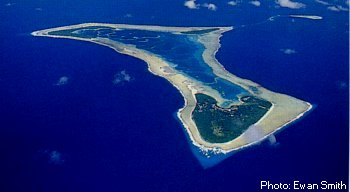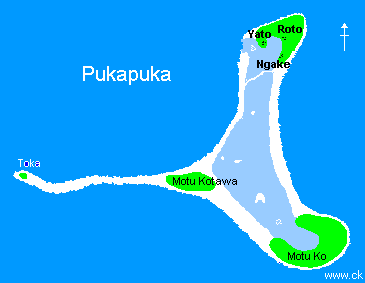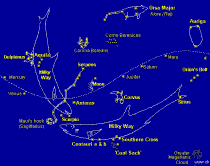Pukapuka - The Island of Danger
 |
THE MOST isolated island in the Cooks group, Pukapuka is a true atoll comprising three islets and a sandbank -- the whole shaped like a three-bladed fan. It lies 715 miles (1150 km) north-west of Rarotonga and is one of the most remote of the Cooks group. It is also difficult for the ordinary traveller to access because although Air Rarotonga flies there it is on an irregular basis which is determined by weather conditions. The small population lives and works as a true commune, often the case with tiny Pacific island communities.
The first and most obvious attribute of Pukapuka is that it is astonishingly beautiful. The anthropologist Ernest Beaglehole described his first sight of it in 1934:-
"White clouds flecked the sky overhead, the sea below us was a tangle of shadowy blues and foaming wave crests, the sun had a caressing warmth about it...we could distinguish the vivid belt of green coconut and pandanus trees poised in the air above beaches of glittering whiteness...coming nearer still, we could make out little coconut-thatched native houses growing as if out of the sandy beach itself."
But it was an American writer, Robert Dean Frisbie, who immortalised Pukapuka in his books "The Book of Puka Puka"and "The Island of Desire". He moved to the atoll in 1924 to become a storekeeper and to seek isolation from the technological world of the 20th century. In 1928 he wrote in the Atlantic Monthly:-
"It comprises three small islets threaded on a reef six or seven miles in circumference, which encloses a lagoon so beautifully clear that one can see the strange forests of coral to a depth of ten fathoms. The islets are little more than banks of sand and bleached coral where coconut palms and pandanus and puka trees break momentarily the steady sweep of the trade wind."
 |
Humans have inhabited Pukapuka from at least 300 BC and excavations have shown that the island was home to humans around 400 AD. An extraordinary archaeological find from 300 BC are dogs' bones big enough to suggest one specimen was similar in size to the ancient dingo of Australia. The skull was larger than the dog skulls excavated from Moorea in the Society Islands. According to Japanese archaeologists there are no archaeological specimens of such large dogs from south-east Asia.
 The Pukapukans are famous sailors and navigators. This version of a Pukapukan star map shows the occidental names of the constellations but with the Polynesian references using the legends, and ocean creatures with which they were familiar. For instance, they saw the Milky Way as two large sharks.
The Pukapukans are famous sailors and navigators. This version of a Pukapukan star map shows the occidental names of the constellations but with the Polynesian references using the legends, and ocean creatures with which they were familiar. For instance, they saw the Milky Way as two large sharks.
It is not known whether Pukapuka was inhabited continuously but it seems fairly certain it was finally settled around 1300 AD from Western Polynesia. The island is extremely important in the arena of Pacific cultural history both because of its geographical location and because its culture has close affiliations with both Eastern and Western Polynesia. The people speak a language more related to Samoan than the Maori tongues of the southern Cook Islands but there is evidence of linguistic influence from eastern Polynesia. Pukapukan oral tradition has it that a tsunami (probably a cyclone-induced wave) struck Pukapuka, from genealogies probably in the early 1600s and killed all the inhabitants except for 15 men, two women and the remnants of their families, an assortment of children and adolescents. These doughty survivors repopulated the island.
Pukapuka has the distinction of being the first of the Cook Islands to be sighted by Europeans. The Spanish explorer Alvaro de Mendaña saw it on August 20 1595 and named it San Bernardo. By a strange coincidence the first Pacific island sighted by Europeans was another Pukapuka, this one in the north-eastern corner of the Tuamotu archipelago, discovered by Ferdinand Magellan on January 24 1521.
The next known European sighting came from a British ship, the "HMS Dolphin", under the command of John Byron on June 21 1765. He could not land because of high surf and dangerous rocks and, such was the paucity of his imagination, named Pukapuka the Island of Danger. In 1857, Polynesian missionary teachers were landed and in 1865 the missionary ship "John Williams" went aground on the reef.
Pukapuka was proclaimed a British protectorate in 1892 and was included in the Cook Islands boundaries under the control of New Zealand in 1901.
Air Rarotonga flies to Pukapuka from Rarotonga irregularly and would-be visitors should check with Air Rarotonga by fax to 682 22 979.
Also in Chinese
| Contents | Location | History | People | Art | Religion | Travel | Events | Sea sport | Govt | Offshore | Investment | Bulletin Board |
Site designed, constructed
and maintained by
Jarvy Web
Revised: July 22 2019
URL: http://www.ck/pukapuka.htm